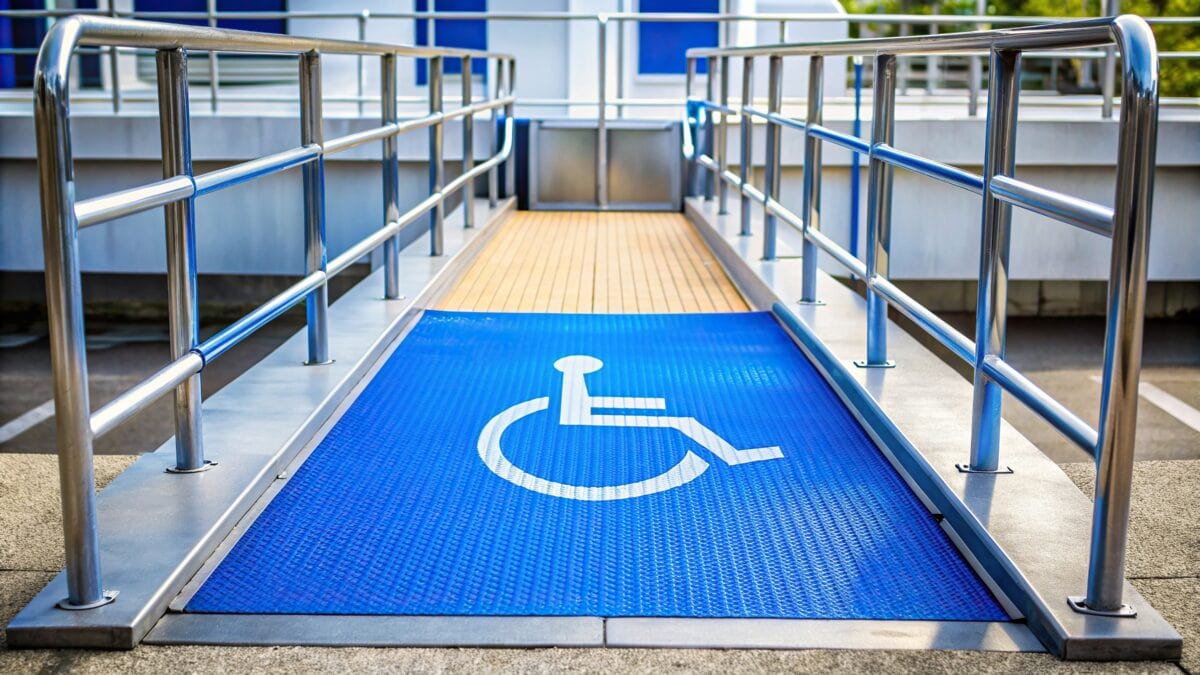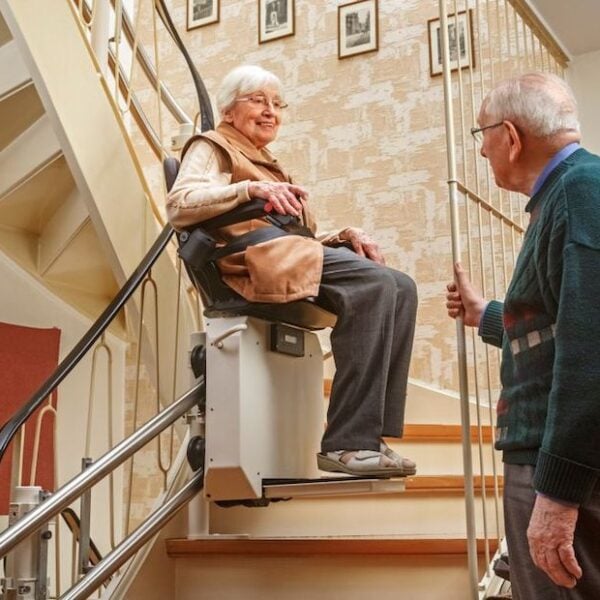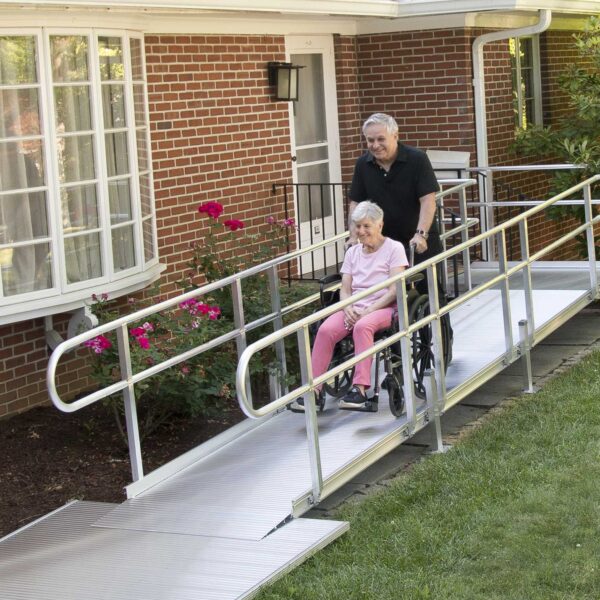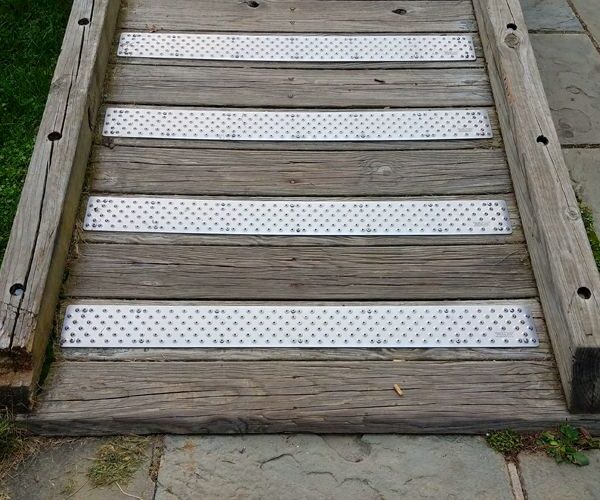
Essential Tips for a Handicap Accessible Bathroom Remodel
May 29, 2024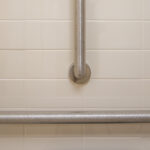
How to Install Grab Bars for Elderly Care
June 11, 2024Navigating the intricacies of ensuring accessibility in homes and businesses can be challenging, but selecting and installing the right wheelchair ramp should never be a hurdle.
Whether you’re considering a sleek, aluminum handicap ramp that glides effortlessly alongside your front porch or a robust, portable ramp for stairs to enhance your building’s usability, the options are limitless.
Our professional installation services streamline the process, delivering ramps that comply with the Americans with Disabilities Act of 1990 and a newfound sense of independence to our clients.
We’ll discuss design considerations, the construction process, and how accessible modifications can vastly improve daily experiences for people with mobility aids.
Keep reading to discover the transformative power of expertly installed ramps and how they contribute to a safer, more inclusive environment.
Choosing the Perfect Wheelchair Ramp for Your Home
Embarking on the journey to select a wheelchair ramp can be a blend of excitement and concern.
It’s thrilling to envision improved accessibility in your home, but it’s vital to ensure that the chosen solution perfectly aligns with the user’s distinct mobility needs.
As I’ve repeatedly advised clients, it is imperative to thoughtfully evaluate both the user’s mobility aid—whether it’s a scooter or wheelchair—and their physical capabilities.
This process parallels analyzing your home’s existing layout and any structural limitations.
From the robustness of your porch to the integrity of the entranceway, understanding these variables is essential.
After all, a ramp should seamlessly integrate into the space, enhance safety, and elevate the user’s quality of life.
Assessing the User’s Mobility Requirements
When assessing the user’s mobility requirements, the objective is to bridge the gap between their daily routines and the independence they crave. This demands an intimate understanding of their challenges and the specific features of their mobility aid. As an industry expert, I’ve seen clients achieve transformative results simply by opting for custom solutions that address the nuances of their physical disability.
- Determine the wheelchair or scooter dimensions, weight capacity, and turning radius to ensure compatibility with the ramp design.
- Assess the user’s strength and dexterity, particularly their ability to maneuver over thresholds or switch between different types of surfaces.
- Contemplate future mobility changes that might factor into the longevity and adaptability of the chosen ramp.
Evaluating Space and Structural Constraints
Turning our attention to the physical attributes of your abode, the triumph of a portable ramp installation hinges on a meticulous evaluation of space and structural constraints. It’s a matter of determining whether your threshold requires a compact, foldable option or if your lawn could accommodate an aluminum ramp winding gently to your porch. Each scenario dictates a nuanced approach – a lightweight, removable ramp would minimize obstruction in a narrow hallway. In contrast, larger areas offer the liberty to explore more permanent, ADA-compliant solutions that blend with the existing architecture.
Steps to Professional Wheelchair Ramp Installation
Embarking on the installation of a wheelchair ramp is not a mere construction project; it’s an intricate endeavor that blends precision with compassion.
My role as a professional involves more than establishing the groundwork – it’s about forging a solution that resonates with individual needs.
From the moment you reach out for an initial consultation, my aim is to provide a comprehensive site evaluation, meticulously assessing every inch of the intended area.
The quest doesn’t end with taking measurements; it transcends into designing a custom ramp solution that caters to personal preferences, specific mobility requirements, and your property’s unique layout.
These initial steps lay the cornerstone for creating an accessible, safe, and aesthetically pleasing pathway to independence.
Initial Consultation and Site Evaluation
During an initial consultation and site evaluation, I focus on deeply understanding the client’s unique needs and property specifics. This is an all-encompassing approach: I look at the entry points, consider the environment, discuss preferences, and envision what will enhance not only accessibility but also the home’s overall function and appeal. This dedication to tailored service sets the foundation for a successful wheelchair ramp installation.
| Step | Action | Detail |
|---|---|---|
| 1 | Client Consultation | Discuss mobility needs, preferences, and long-term requirements |
| 2 | Site Evaluation | Assess environment, entry points, and space constraints |
| 3 | Personalization | Consider user-specific customization for optimal independence |
| 4 | Design Proposal | Create plans that align with client’s needs and property specifics |
Designing a Custom Ramp Solution
As I transition from assessment to design, I commit to formulating a ramp solution that gracefully suits your unique situation. This is where my experience comes into play, ensuring that every ramp we construct not only complies with the Americans with Disabilities Act of 1990 (ADA) standards but also reflects the personal aesthetics and functionality desired. The fusion of safety, usability, and design excellence lies at the heart of every blueprint I render, resulting in a ramp that is not just a mobility aid but an extension of the home itself.
The Benefits of Hiring Professional Installers
Delving into the realm of professional installation services for wheelchair ramps reveals the unparalleled benefits of expertise and quality assurance.
Mastery in understanding and adhering to compliance and safety standards is paramount. This ensures that each ramp meets the precise needs of its users while conforming to the Americans with Disabilities Act (ADA) guidelines.
In addition, a commitment to quality workmanship and the insistence on premium materials not only promises durability but also instill confidence that the ramp will stand the test of time, offering peace of mind and unwavering support for mobility across the seasons.
Expertise in Compliance and Safety Standards
When you enlist professional installers for your wheelchair ramp needs, you gain access to a wealth of knowledge of compliance and safety standards. These experts ensure that every aspect of the ramp – from slope ratio to handrail height – adheres strictly to ADA guidelines, thereby optimizing user safety and functionality. Their precise attention to detail assures that the installment promotes accessibility while maintaining the highest standards of construction integrity.
| Step | Expert Action | Compliance and Safety |
|---|---|---|
| 1 | Design Review | Ensure plans meet ADA standards for slope, width, and surface |
| 2 | Material Selection | Choose materials that offer durability and weather resistance |
| 3 | Installation Process | Apply technical expertise to secure proper ramp anchoring and stability |
| 4 | Safety Inspections | Conduct thorough checks to validate ramp safety pre- and post-installation |
Guarantee of Quality Workmanship and Materials
Entrusting your wheelchair ramp installation to professionals means investing in expertise and securing peace of mind with workmanship built to last. My team and I select only the finest materials, from rust-resistant aluminum to robust steel, ensuring every installation can withstand the tests of time and weather. What’s more, our commitment to excellence means delivering a finished product that meets your specific needs and exceeds industry standards, guaranteeing a ramp that’s as reliable as it is functional.
Innovative Wheelchair Ramp Solutions for Businesses
Stepping beyond the confines of residential wheelchair ramp solutions, my professional acumen extends to businesses seeking to embrace inclusivity.
Recognizing the impact of effortless access on customer experience and corporate responsibility, we delve deeply into ADA guidelines and craft ramps that comply with these regulations and elevate the premise’s accessibility.
By offering custom-tailored solutions that resonate with the brand’s identity and architectural aesthetics, we empower enterprises to welcome all patrons with open arms, stressing the importance of accessibility as a keystone to business success.
Understanding ADA Guidelines for Commercial Ramps
Under the vigilant lens of business responsibility, understanding ADA guidelines is non-negotiable for commercial ramp installations. Meeting these standards ensures legal compliance and reflects a company’s dedication to serving a diverse clientele. This mission involves critical assessments of ramp length, width, and slope to guarantee safe navigation for all, regardless of their mobility impairments.
- Assess the necessity for ramps at all public entrances following ADA accessibility guidelines.
- Analyze the prescribed slope, landing dimensions, and railings that meet ADA requirements for safe wheelchair maneuverability.
- Consult an ADA-compliant expert to verify that the ramp design satisfies the client’s needs and ADA standards for commercial properties.
Tailoring Ramps to Enhance Customer Accessibility
Adopting a bespoke approach to ramp design, I work closely with businesses to create ramps that provide seamless access for customers with different mobility needs and harmonize with the establishment’s décor and structural design. It’s about crafting an accessible entrance that reflects the company’s commitment to inclusivity, ensuring every customer feels valued and welcomed when they approach the property.
Maintenance Tips for Your New Wheelchair Ramp
Once your ramp is expertly installed, maintaining its condition is pivotal for prolonging its lifespan and ensuring it remains a dependable support for everyday mobility.
Regular cleaning practices are essential to keep it clear of debris and to preserve its novelty—akin to tending to a valued piece of machinery.
Moreover, as the seasons change, it becomes increasingly important to conduct specific maintenance checks.
This proactive approach safeguards against wear and ensures the ramp’s safety features always operate at their best.
These habits, ingrained in the routine of ramp upkeep, are key to seamless functionality and enduring stability.
Regular Cleaning Practices for Longevity
Embracing a regimen of regular maintenance, I always remind clients that the upkeep of their wheelchair ramp is pivotal for ensuring its longevity. I stress the importance of periodic cleaning to prevent the accumulation of dirt, leaves, and snow, which can lead to surface degradation and slippery conditions. This attention to detail maintains the ramp’s structural integrity and guarantees safe passage year after year.
Seasonal Maintenance Checks to Ensure Safety
As the season transitions, conducting thorough maintenance checks on the ramp becomes an imperative part of safeguarding continuous safety: From the abrasive effects of salt during winter snowfalls to the expansion of metal in the summer heat, each season introduces unique challenges that can impact the ramp’s structural integrity and surface traction.
- Perform a detailed inspection of the ramp’s surface for any signs of wear, such as cracks or warping, which are more prone to occur following extreme weather changes.
- Examine all connecting joints, bolts, and handrails to ensure they remain secure and have not been loosened by temperature fluctuations or heavy usage.
- Apply anti-slip treatments and remove any debris or buildup that could make the ramp hazardous, particularly after autumn leaves or winter snow and ice.
Professional wheelchair ramp installation services ensure that each ramp meets ADA compliance and safety standards and is custom-tailored to the individual’s mobility needs and the property’s specific conditions.
Expert installers bring invaluable precision to the design and construction process, selecting high-quality materials to guarantee a durable and secure result.
A well-installed wheelchair ramp enhances the user’s independence and the home’s accessibility, significantly improving the quality of life.
By entrusting this crucial addition to CAPS Remodeling, homeowners and businesses can rest assured that the ramps are safe, functional, and seamlessly integrated into the existing space.

Introducing Jeff Cates, the visionary Founder and Owner of CAPS Remodeling. After experiencing a profound personal event involving his son in 2007, Jeff was inspired to serve a higher purpose: to create safer, more comfortable, and independent living conditions for the elderly and disabled by modifying their current homes. Jeff’s deep-seated religious beliefs form the moral compass that steers CAPS daily operations. Apart from his unwavering dedication to his work, Jeff finds joy in boating and cherishing moments with his family.

